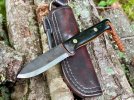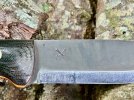- Joined
- Jul 31, 2019
- Messages
- 32
I have recently soaked a vintage knife in white distilled vinegar. The knife had barely any rust on it, but after soaking it in vinegar for a couple of days I took it out and it was severely pitted all over including so much pitting on the edge it went from a straight and fairly even edge to essentially a serrated edge. Why does this happen? Am I soaking it too long? Does the vinegar go beyond loosening and removing rust to actually eating away at the blade or are the knives I've done this with have smaller rust and pitting that I don't initially realize? The blades are ruined...


Last edited:






